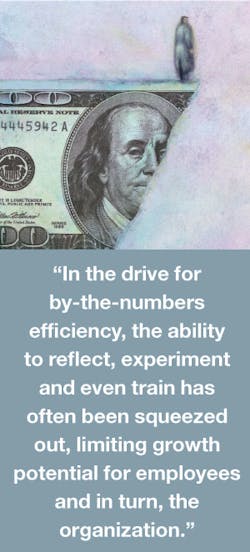Lessons From the Road: The More of Do More With Less
In the last installment of "Lessons from the Road," I focused on waste elimination. I explained that with the common definition of lean -- "do more with less" -- we should focus as much on the "do more" as the "with less." What does "do more" really look like?
See Also: Operations Management Strategy & Best Practices
There are several areas in which "doing more" should receive the attention of lean thinkers. If waste elimination is about eliminating activities that do not add value, then we should start with how we can provide more value.
1. Improve the customer interaction. So much strategic attention is focused on what product or service organizations provide that far too little attention is paid to how the customer gets access to it. The adage of "build a better mousetrap and they will beat a path to your door" assumes you haven't already provided that path and paved it with lights and signs.
Amazon.com is a great example of this with its 1-Click Ordering. How much easier is it to buy product from this source than most other websites? First, of course, you have to have the right product at the right price. But once the customer is ready to buy, it certainly helps to make that experience as easy as possible.
2. Make your customer's first step your last. When most organizations think of vertical integration, they think of working backwards into their suppliers. But forward integrating into your customer can be even more valuable, especially when you are taking over steps that your customer doesn't want to perform.
The classic example was the home grill. Home grill assembly caused great agony; yet it seemed to take retailers generations to figure out how much value they could provide by assembling it for you. The engineered lumber industry has gone forward into the work of home builders by using laser alignment and automation to pre-build walls straight from the factory. This allows construction companies to simultaneously improve quality and reduce lead-time.
3. Complete the life cycle. Too often we disengage with the customer after the initial product or service has been delivered. Yet completing the life cycle of the product not only provides more value for the customer, but it also gives them a reason to reconnect. Best Buy, among others, has been offering free electronics recycling, even if you didn't buy the product there. This eliminates the danger inherent in throwing away electronics and brings you back into the store where you might find that perfect replacement product.
4. Learn and build a capable organization. Doing more isn't just about providing more value, but is also about building a more capable organization -- an organization that has people who know performance, and have the skills and the mindset to improve everyday. In the drive for by-the-numbers efficiency, the ability to reflect, experiment and even train has often been squeezed out, limiting growth potential for employees and in turn, the organization.
When the auto industry went through a major downturn, with many companies turning to the government for help, Toyota didn't lay off its employees. Instead it focused their spare time on improvement efforts, training and doing projects within the local communities, which brought them goodwill where they operate.
In another example from Amazon.com, salaried employees spend a week answering calls in the call center. This generates empathy and insight for the customer, and has lead directly to many innovations in improving the customer experience. It would be hard to create training powerful enough to help people understand the customer more than this direct engagement generates.
Don't make lean only about efficiency and waste elimination. Make lean first about effectiveness and customer value.


